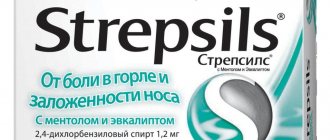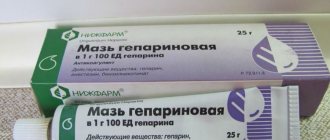Lidocaine
The toxicity of lidocaine increases when it is used simultaneously with cimetidine and propranolol due to an increase in the concentration of lidocaine; this requires a reduction in the dose of lidocaine. Both drugs reduce hepatic blood flow. In addition, cimetidine inhibits the microsomal activity of liver enzymes.
Ranitidine, Diltiazem, verapamil, propranolol and other β-blockers reduce the clearance of lidocaine, which leads to an increase in its concentration in the blood plasma.
Antiviral agents (eg, amprenavir, atazanavir, darunavir, lopinavir) can also cause increased serum concentrations of lidocaine.
Hypokalemia caused by diuretics may reduce the effect of lidocaine when used simultaneously (see section "Special Instructions"). Lidocaine should be used with caution in patients receiving other local anesthetics or agents structurally similar to amide-type local anesthetics (eg, antiarrhythmic agents such as mexiletine, tocainide) because systemic toxic effects are additive.
When lidocaine is used in combination with narcotic analgesics, hexenal or sodium thiopental, the inhibitory effect on the central nervous system and respiration may be enhanced.
Separate drug interaction studies have not been conducted between lidocaine and class III antiarrhythmic drugs (eg, amiodarone), but caution is recommended when using them together.
In patients concomitantly receiving antipsychotics that prolong or have the potential to prolong the QT interval (e.g., pimozide, sertindole, olanzapine, quetiapine, zotepine), prenylamine, epinephrine (with occasional intravenous administration), or 5-HT3-serotonin receptor antagonists (e.g., tropisetron, dolasetron), the risk of developing ventricular arrhythmias may increase.
Concomitant use of quinupristin/dalfopristin may increase lidocaine concentrations and thus increase the risk of developing ventricular arrhythmias; their simultaneous use should be avoided.
Patients receiving muscle relaxants (eg, suxamethonium) may have an increased risk of enhanced and prolonged neuromuscular blockade.
Cardiovascular insufficiency has been reported following the use of bupivacaine in patients receiving verapamil and timolol; lidocaine is similar in structure to bupivacaine.
Dopamine and 5-hydroxytryptamine lower the seizure threshold in patients receiving lidocaine.
Opioids appear to have anticonvulsant effects, supported by evidence that lidocaine lowers the seizure threshold to fentanyl in humans.
Combinations of opioids and antiemetics, sometimes used for sedation in children, may lower the seizure threshold to lidocaine and increase its CNS depressant effects.
The use of epinephrine with lidocaine may reduce systemic absorption, but with accidental intravenous administration the risk of ventricular tachycardia and ventricular fibrillation increases sharply.
Concomitant use of other antiarrhythmic drugs, beta-blockers and slow calcium channel blockers may further reduce AV conduction, ventricular conduction and myocardial contractility.
The simultaneous use of vasoconstrictors increases the duration of action of lidocaine.
Concomitant use of lidocaine and ergot alkaloids (eg, ergotamine) can cause severe hypotension.
Caution must be exercised when using sedatives as they may interfere with the action of local anesthetics on the central nervous system. Caution should be exercised when using antiepileptic drugs (phenytoin), barbiturates and other inhibitors of liver microsomal enzymes, as this may lead to decreased effectiveness and, as a result, an increased need for lidocaine. On the other hand, intravenous administration of phenytoin may enhance the depressant effect of lidocaine on the heart.
The analgesic effect of local anesthetics can be enhanced by opioids and clonidine.
The combined use of lidocaine with procainamide can cause central nervous system stimulation and hallucinations.
When using lidocaine and polymyxin-B simultaneously, it is necessary to monitor the patient's respiratory function. Ethyl alcohol, especially with prolonged abuse, can reduce the effect of local anesthetics. Lidocaine is not compatible with amphotericin B, methohexitone, nitroglycerin.
With the simultaneous use of lidocaine with narcotic analgesics, an additive effect develops, which is used during epidural anesthesia, but increases the depression of the central nervous system and respiration.
Vasoconstrictors (epinephrine, methoxamine, phenylephrine) prolong the local anesthetic effect of lidocaine and can cause increased blood pressure and tachycardia.
Use with monoamine oxidase inhibitors (furazolidone, procarbazine, selegipine) probably enhances the local anesthetic effect of lidocaine and increases the risk of lowering blood pressure. Guanadrel, guanethidine, mecamylamine, grimstaphane camsylate increase the risk of a pronounced decrease in blood pressure and bradycardia. Anticoagulants (including ardeparin sodium, dalteparin sodium, danaparoid sodium, enoxaparin sodium, heparin, warfarin, etc.), nonsteroidal anti-inflammatory drugs (NSAIDs) or plasma expanders increase the risk of bleeding.
Lidocaine reduces the cardiotonic effect of digitoxin.
Lidocaine reduces the effect of antimyasthenic drugs (prozerin, oxazil, etc.), enhances and prolongs the effect of muscle relaxant drugs.
When treating the injection site with disinfectant solutions containing heavy metals, the risk of developing a local reaction in the form of pain and swelling increases.
Mixing lidocaine with other medications is not recommended.
Description of the drug
"Lidocaine" is a drug that has a pronounced local anesthetic and antiarrhythmic effect. Producing countries: Russia, Belarus, Hungary, China, Germany. Available in various dosage forms:
- Lidocaine hydrochloride solution 1, 2 and 10% for parenteral administration;
- spray 10% in bottles with metered tip for topical use;
- "Lidocaine" 5% ointment for external use;
- dental gels with Lidocaine, which are available under different trade names;
- eye drops.
Lidocaine is available under various trade names:
- "Xikain";
- Gelicain;
- Dynexan;
- "Versatis";
- Xylocaine.
In medical institutions, an injectable dosage form is used, as well as a spray. The permitted therapeutic dose per 1 hour should not exceed 300 mg. For spinal anesthesia, a maximum of 400 mg is administered. In cardiological practice, with drip infusion, the maximum daily dose is 2 thousand mg.
Mechanism of action
"Lidocaine" belongs to the pharmacological group "local anesthetic and antiarrhythmic drug class IB." Chemically it is an acetanilide derivative.
The mechanism of action of Lidocaine is as follows:
- blocks sodium channels of the membranes of cardiocytes and neurons;
- has a local anesthetic effect, which is explained by the stabilization of cell membranes, as a result of which impulse conduction is reduced;
- suppresses the automaticity of Purkinje fibers;
- inhibits ectopic foci of excitation by reducing the activity of areas that cause arrhythmia.
Lidocaine first reduces pain and then tactile sensitivity. At a therapeutic dose, it does not affect myocardial contractility. To relieve arrhythmia when administered intravenously, it acts quickly and briefly. When used intramuscularly, the effect occurs within 5–15 minutes. When applying the spray to the skin and mucous membranes, the effect develops after a quarter of an hour.
"Lidocaine" first enters organs with good blood circulation - the brain, heart, lungs. When infused, it penetrates into the placenta and breast milk. In chronic renal failure, the medication may accumulate.
Where is it used?
Aerosol "Lidocaine" is used for local anesthesia in various fields of medicine:
- when piercing the maxillary sinus and washing it, resection of nasal polyps;
- during tonsillectomy, adenomotomy, opening of paratonsillar abscess;
- during surgical procedures in dentistry;
- for anesthesia of the pharynx during insertion of a gastroduodenal tube and replacement of a tracheotomy tube;
- in gynecology during manipulations in the cervical area;
- in the treatment of superficial suppurative processes;
- before performing rectoscopy;
- when removing stitches.
It is used intramuscularly and intravenously in various fields of medicine:
- in cardiology during an attack of tachyarrhythmia, extrasystole, flutter, fibrillation;
- in case of myocardial infarction in case of rhythm disturbance;
- when implanting a pacemaker;
- in neurology it is used for myositis, vertebrogenic lesions of the spine;
- during epidural, conduction and superficial infiltration anesthesia.
In ophthalmology, eye drops are used for pain relief.
In surgery it is used to block nerve nodes and fibers.
Side effects
Patients tolerate Lidocaine aerosol well in most cases. Sometimes there is a burning sensation or a local allergic reaction. With general effects, the drug can depress or stimulate the central nervous system, as well as reduce the activity of the heart and blood vessels.
Systemic side effects of Lidocaine are as follows.
- On the part of cardiac activity, blockade, bradycardia, conduction disturbances, decreased or increased blood pressure are observed.
- The main disorders of the nervous system are euphoria, excitement or depression of consciousness, dizziness. In more severe cases, muscle twitching and cramps appear.
- Allergic reaction - urticaria, angioedema (Quincke's edema), anaphylactic shock.
- From the gastrointestinal tract, nausea or vomiting is observed.
Local phenomena are noted - a feeling of cold or heat, numbness of the limbs.
Contraindications
- The use of Lidocaine is strictly prohibited in case of hypersensitivity.
- A contraindication is a history of seizures following previous administration.
- The drug is not used for cardiac conduction disorders - blockades, weakness of the sinus node, Wolff-Parkinson-White syndrome.
- An absolute contraindication is cardiogenic shock.
- The use of Lidocaine is contraindicated for pregnant women, nursing mothers and children under 12 years of age.
When does an overdose occur?
For what reasons is lidocaine poisoning possible?
There are several factors that contribute to drug overdose. Factors:
- Use in case of intolerance to components,
- Increased patient sensitivity
- Use on damaged areas of the skin,
- Introducing into blood vessels
- Accelerated absorption from an area with an increased number of blood vessels,
- Improper use.
An overdose is caused by the use of a substance in an increased dosage.
Treatment in hospital
Upon admission to the hospital, a person is provided with the following emergency measures.
- Tracheal intubation for connection to a ventilator (artificial pulmonary ventilation).
- Administration of anticonvulsants (Diazepam, Sodium Thiopental).
- Intravenous infusion of plasma substitutes - "Reopoliglyukin", "Polyglyukin", as well as electrolyte solutions - "Lactasol", sodium chloride.
- For bradycardia, atropine is administered.
- The specific antidote for Lidocaine is a 30% solution of sodium thiosulfate, which is administered intravenously.
Such activities are carried out in the intensive care unit.
Dosage and symptoms of poisoning
How much lidocaine can be used? The dosage of the medicine is selected individually for each patient. It is recommended to administer a minimum of the drug if this amount allows you to achieve the desired effect.
The maximum volume in adults is no more than 300 (rarely 400) mg for sixty minutes. This is a single permissible dose. The highest level per day can reach two thousand milligrams.
In children under three years of age, it is allowed to administer no more than 1.25 mg per kilogram of weight no more than four times a day. The maximum allowable value is 4 ml of lidocaine per kg in twenty-four hours. If the specified amounts are exceeded, an overdose may develop.
Overdose symptoms
How to determine the presence of an overdose? Lidocaine intoxication is manifested by specific symptoms; signs of dysfunction of the central nervous system are diagnosed. What do you need to pay attention to?
Signs:
- Tingling sensation on the skin around the lips,
- Increased sweating
- Pale upper layer of the epidermis,
- Feeling chilly
- Lethargy or state of excitement,
- Painful sensations in the head, dizziness,
- Disturbances in visual functions,
- Tremor of the limbs, convulsive manifestations,
- Low blood pressure, low pulse,
- Heart rhythm disturbance
- Disturbances in the respiratory process,
- Cardiac arrest, loss of consciousness, death.
The acute form of overdose manifests itself quite quickly. The risk of poisoning increases with intravenous administration of the drug.
Consequences and prevention
How does drug intoxication affect the body? The consequences of an overdose of lidocaine can be serious.
Complications:
- Respiratory disorder
- Development of poor conduction of the heart muscle,
- Collapse,
- Various allergic manifestations,
- Death.
Overdose can be avoided if you use lidocaine strictly according to the instructions. It is necessary to select the correct dosage, do not use the drug in the presence of allergic reactions and in children under one year of age. The lidocaine solution is administered by experienced personnel.
An overdose of lidocaine poses a danger to the human body. If signs of poisoning appear, you must quickly provide the necessary assistance to the victim and call doctors.
We recommend: Manganese poisoning in children and adults - symptoms and diagnosis
When medical attention is needed
In case of lidocaine intoxication, it is imperative to contact a medical facility. If there is no necessary assistance in case of an overdose, the patient may experience cardiac arrest and death. In some cases, an overdose poses a danger to a person.
Dangerous:
- Loss of coordination, orientation, lethargy,
- Malfunctions of the cardiac system, sudden changes in blood pressure,
- Breathing problems
- Blueness of the skin,
- Impaired consciousness.
In such cases, medical assistance in case of overdose is required.
First aid and treatment
In most cases, an overdose occurs in a medical facility.
However, if symptoms of poisoning from using the drug at home are detected, you must immediately call a team of doctors. We recommend: Diclofenac overdose: symptoms and consequences of poisoning
Before arrival, the patient is provided with first aid, which includes a number of actions aimed at alleviating the condition.
What to do:
- Stop administering the drug
- When using the medicine externally, rinse the surface with cool water,
- The patient is kept at rest, placed on a horizontal surface, tight clothing is unbuttoned, and fresh air is provided.
- The arriving doctors explain the situation and describe the actions taken (first aid provided).
There is no specific antidote for an overdose of this drug. In such a situation, 30% sodium thiosulfate is used, administered intravenously. Treatment is carried out in a medical institution, actions are aimed at restoring normal functionality of the body.
Actions:
- Using a ventilator, performing intubation,
- Intravenous administration of specific recovery solutions and plasma substitutes,
- Anticonvulsants and M-anticholinergics are prescribed.
- If the heart beats rarely, atropine is administered.
Overdose is treated until the functionality of all systems and organs is completely normalized.
Overdose symptoms
In case of an overdose of Lidocaine, signs of inhibition of the activity of the heart and nervous system are observed. Characteristic is a gradual increase in the severity of the condition.
numbness of the tongue
The first signs of an overdose of Lidocaine:
- crawling sensation around the mouth;
- pale skin;
- heavy sweating;
- sudden weakness;
- numbness of the tongue;
- lethargy or agitation;
- dizziness;
- decreased blood pressure;
- tremor;
- episodes of respiratory arrest.
Such symptoms require discontinuation of the medication and provision of therapeutic measures.
tremor
As the patient's condition worsens, the following symptoms of lidocaine poisoning appear:
- depressed consciousness;
- inability to communicate;
- tremor;
- convulsions;
- pronounced cyanosis of the skin and mucous membranes;
- heart rhythm disturbance;
- decreased blood pressure;
- pathological change in breathing.
These signs require emergency hospitalization.



